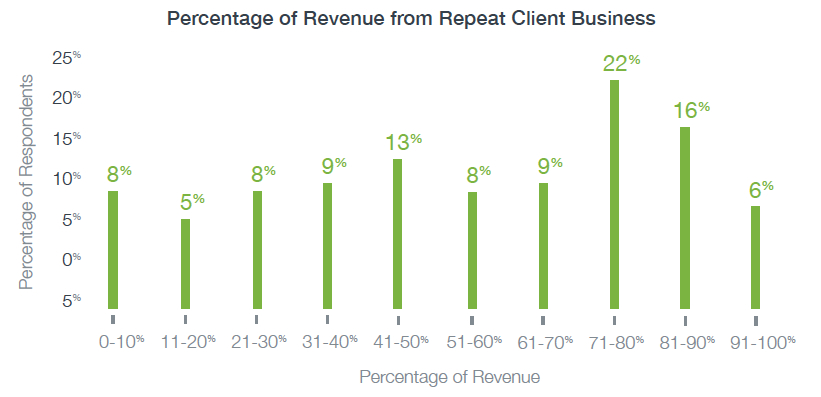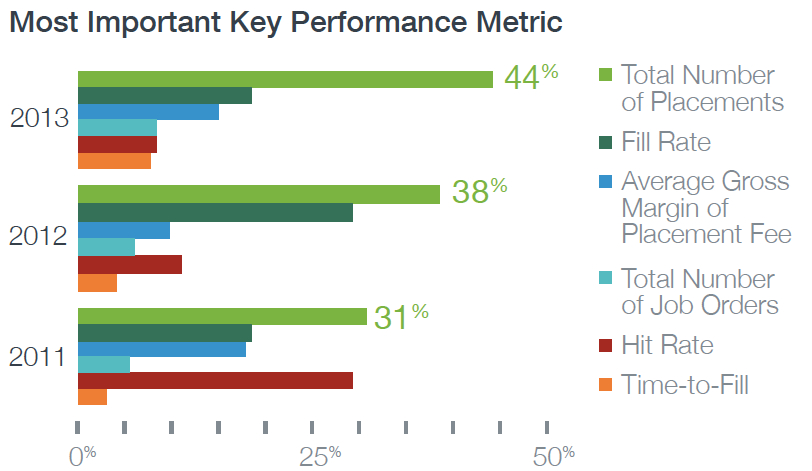![]() Bullhorn done did it again. Today, the staffing software giant released its fourth annual Recruiting Trends Report. In December 2013, Bullhorn polled 1,337 agency professionals to get a sense not only of 2013 but also what to expect in the future of staffing agency trends.
Bullhorn done did it again. Today, the staffing software giant released its fourth annual Recruiting Trends Report. In December 2013, Bullhorn polled 1,337 agency professionals to get a sense not only of 2013 but also what to expect in the future of staffing agency trends.
As a corporate recruiter, I’m not as up close and personal with the agency side, but I have many friends who are and the findings were not terribly surprising, confirming some of the larger staffing agency trends and themes that have long existed in third party recruiting.
Growth
 Is the recession finally over? Does the growth in recruiting agencies finally signal that the job market is turning around? Or are we just moving the same players from one company to the next?
Is the recession finally over? Does the growth in recruiting agencies finally signal that the job market is turning around? Or are we just moving the same players from one company to the next?
With 77% of respondents reporting they’ve met their revenue goals, this should be good news. After all, it tops the percentage reported for the last three years. But could it be a sign that we’re setting our goals lower? Even with revenue goals being met or even exceeded, only 23% of firms are planning on opening new offices.
Makes you wonder just how aggressive these revenue projections really are. While the most successful (per recruiter numbers) were reported by larger staffing firm, these same firms reported most of their revenue coming in from large, repeat customers. The Walmart model of recruiting? Maybe so…
While the repeat business is definitely a positive, nearly half of respondents at firms with between 26 and 74 recruiters and sales people reported getting at least 70% of their revenue from a single client. As an agency recruiter this would freak me out, not to mention what the potential for razor thin margins. Are the recruiters actually making any money for making placements?
Metrics
 Let’s face it – the placement is king. None of this revenue stuff happens without placing candidates. So what does that look like?
Let’s face it – the placement is king. None of this revenue stuff happens without placing candidates. So what does that look like?
It’s not surprising that retained executive search has the highest fill rate, while contingent the lowest.
Executive searches can go on for months, whereas contingent are often competing with other agencies or even internal recruiting efforts. If a contingent role isn’t filled quickly, it may not be filled at all.
On average, respondents are filling only 46% of the open positions they report. LESS THAN HALF.
Does this number bother anyone else? Maybe I’ve been inside too long, but I remember how tough the business development piece is. All that work to actually fill and bill less than half?
Maybe this is what success looks like, but I would have expected closer to 60-70%. This leads me back to the main question I would have as a contributor – how does this affect MY bottom line?
Candidates
 All these placements being made, at all these clients? Yeah – doesn’t happen without candidates. With social media being the “next big thing” in recruiting, surely the latest shiny objects have contributed the most candidate flow, right?
All these placements being made, at all these clients? Yeah – doesn’t happen without candidates. With social media being the “next big thing” in recruiting, surely the latest shiny objects have contributed the most candidate flow, right?
Apparently not. Nearly half (49%) of placements were made with candidates straight out of the recruiters’ own databases.
Social media still had an impact, as did job boards with most large firms reporting boards to be the number one source of qualified candidates. Unfortunately, “social media” was never actually defined.
Does this include LinkedIn? Twitter? Facebook? Until there’s some sort of consensus on what social media really means, these numbers are sort of meaningless.
There were a few other areas broken down, including recruiter compensation (which seemed a little low to me, and was flat relative to years’ passed).
Also, in terms of greatest opportunity and biggest threat – social media for the opportunity win (seriously?) and lack of qualified candidates keeps us up at night.
Overall, the report was not surprising. The numbers reflect a lot of what I see and hear from my agency friends. There were definitely some unanswered questions – as I mentioned above meeting revenue goals is one thing, but knowing what the goals are based on (and improvement over previous years) could tell a completely different story.
I wasn’t as disappointed with the information as I’d expected. To be frank the lack of bullshit to blast made this post more difficult to write than I expected. That said, the information was more fluff and less substance.
I didn’t get a whole of lot insight I didn’t already have and not much in the way of trends moving forward. I guess we have to find some futurist “thought leaders” to weigh in on that. In this industry, that shouldn’t be too tough.
For a full copy of Bullhorn’s recently released 2014 Recruiting Trends Report, click here.
 About the Author: Amy Ala is a staffing consultant & talent sourcer for Microsoft, where she supports the hardware division as a member of Microsoft’s in-house talent acquisition team.
About the Author: Amy Ala is a staffing consultant & talent sourcer for Microsoft, where she supports the hardware division as a member of Microsoft’s in-house talent acquisition team.
Amy has over a decade of recruiting experience, starting her career in agency recruiting running a desk for companies like Spherion, Act One and the Lucas Group before making the move in-house, where she has held strategic talent roles for the State of Washington’s WorkSource employment program and Zones, an IT product and services hub.
Amy is also a featured blogger on RecruitingBlogs.com and is a member of RecruitingBlogs’ Editorial Advisory Board. Follow Amy on Twitter @AlaRecruiter or connect with her on LinkedIn.
By Amy Miller
Amy Miller is a staffing consultant & talent sourcer for Microsoft, where she supports the hardware division as a member of Microsoft’s in-house talent acquisition team. Amy has over a decade of recruiting experience, starting her career in agency recruiting running a desk for companies like Spherion, Act One and the Lucas Group before making the move in-house, where she has held strategic talent roles for the State of Washington’s WorkSource employment program and Zones, an IT product and services hub. Amy is also a featured blogger on RecruitingBlogs.com and is a member of RecruitingBlogs’ Editorial Advisory Board. Follow Amy on Twitter @AlaRecruiter or connect with her on LinkedIn.
Recruit Smarter
Weekly news and industry insights delivered straight to your inbox.





